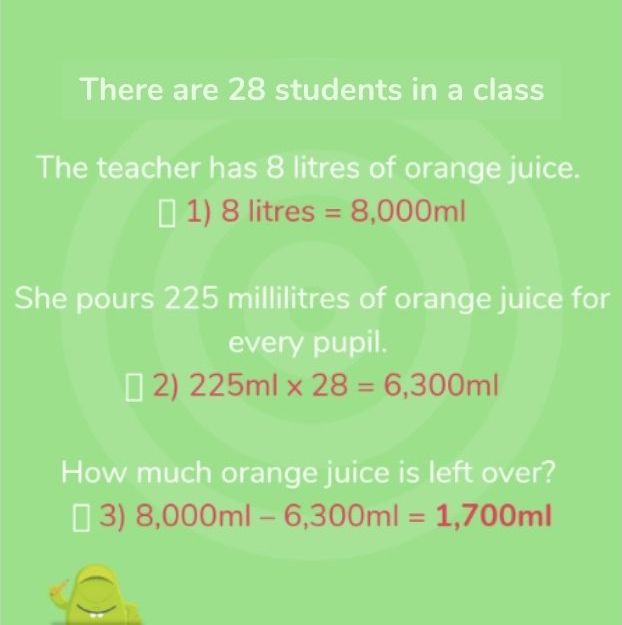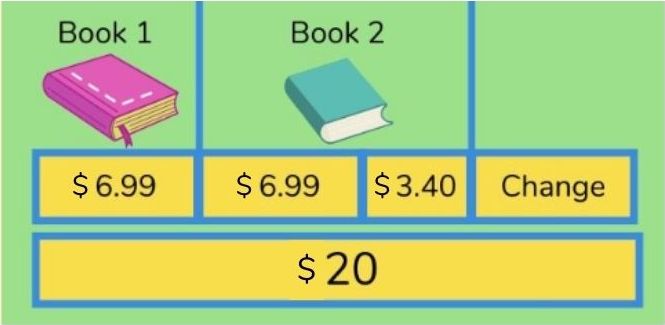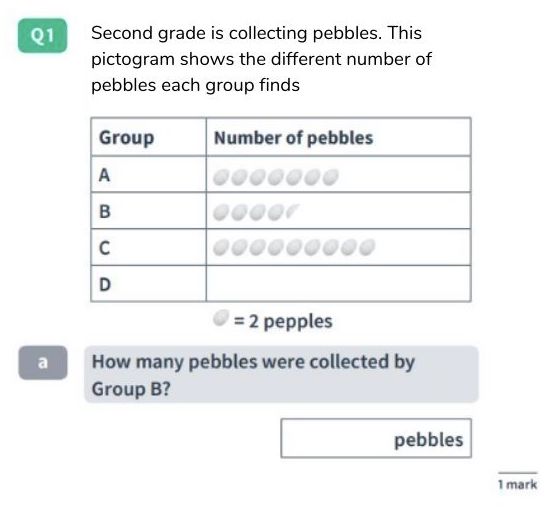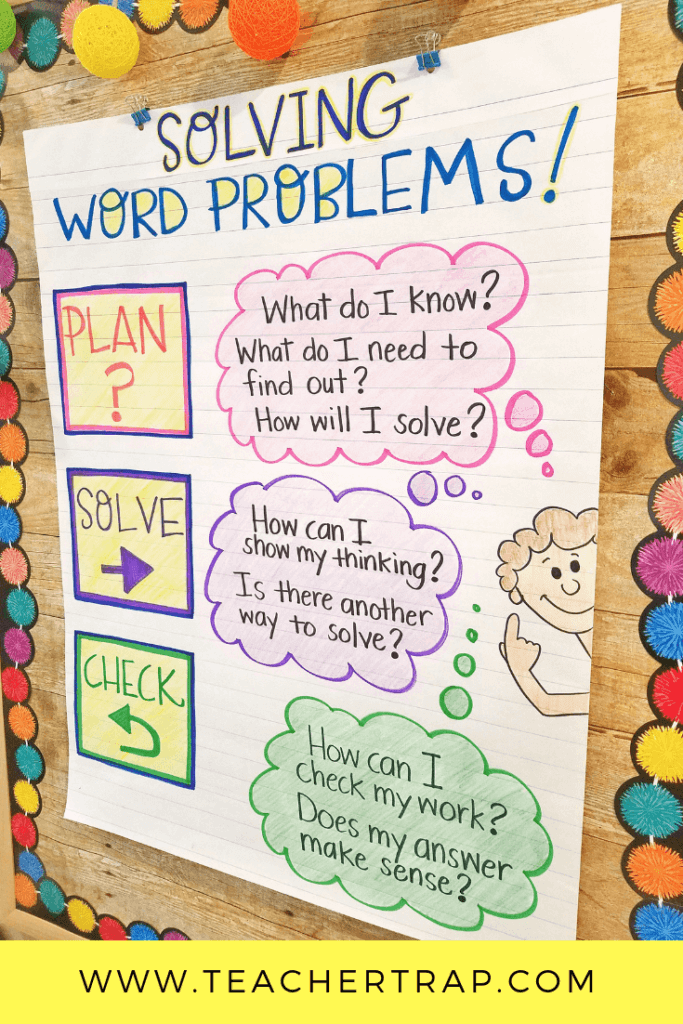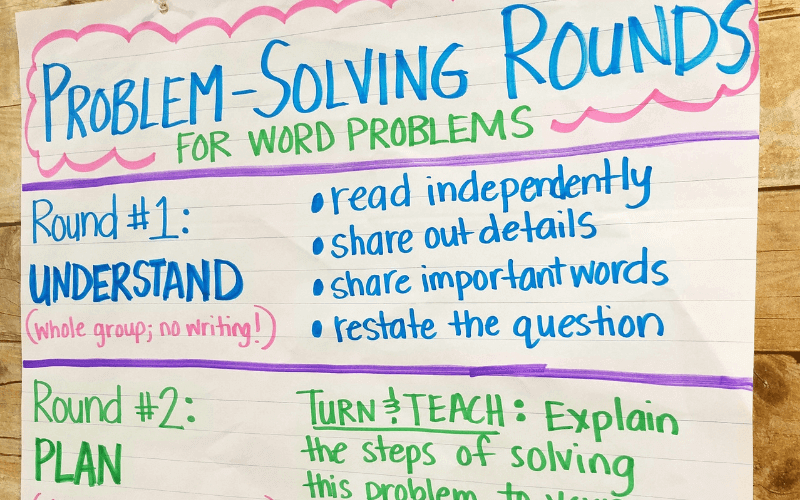Is it a challenge for your students to break down word problems? Do they struggle with identifying the operation, solving the problem, justifying their answer, or all of the above? This can definitely be a challenge for your students and you when this happens (and it seems to happen every year). This post will share some strategies for teaching word problems and a set of free word problems that are perfect for math intervention activities and remediation.
Strategies for Word Problem Math Intervention
Here are some of the strategies and activities that I use to support my students with word problems:
- Introduce new math problems with a context in the form of a relatable word problem
- Expose my students to a variety of word problems regularly and consistently > The free set of word problems will help with this.
- Model my thinking when reading and solving word problems
- Provide my students with a step-by-step way to work through understanding and solving a word problem > The free set of word problems will help with this.
- Get hands-on…use hands-on sorts and moveable digital activities to have my students interact with word problems > The free set of word problems will help with this.
- Teach situations and contexts and not key words when it comes to determining the operation needed. Click here to read a post about using situations and not relying on key words to solve word problems.
- Allow for opportunities for students to share and discuss word problem solving strategies
Now, let’s take a look at the free set of word problems that will give you some free math intervention activities to help your students master word problems.
About the Free Word Problems
This set of free word problems includes two different math intervention activities that focus on word problems.
- The first set of word problems help students conquer word problems by helping them break down the problem and organize their plan for solving.
- The second set of word problems is a sort where students sort word problems according to the operation needed to solve them.
The free word problems focus on basic multiplication and division math facts.
This will allow you to focus on teaching your students the strategy of breaking down a word problem (with the help of a graphic organizer) without being bogged down by difficult math concepts.
Math Intervention Word Problems – Graphic Organizer Activity
The first set of word problems includes 10 multiplication and division word problems with a graphic organizer. The organizer helps students break down the steps of solving the word problem.
The graphic organizer for each problem asks the students to:
- Retell the problem
- Select the operation and reason for selecting that operation
- Solve the problem
- Defend why the answer makes sense
- Prove the answer
I have also included the word problems in a copy friendly version with 8 word problems on a page and blank templates of the graphic organizer. You can use laminated copies of the blank template and have students write on them with dry erase markers. This makes it super easy to use during stations and guided math groups.
Note: It can be time-consuming to complete all parts of the graphic organizer each time if used regularly. Feel free to have students only complete specific sections as needed. You could even start with just having them retell the problem, select the operation, and then solve the problem. Then you can move to the other sections later on. Alternatively, you can skip the retelling and focus on the defending and proving sections.
Math Intervention Word Problems – Sort Activity
Word problems are a difficult math skill to make hands-on but anytime I can make something hands-on, the better my students do.
The second set of word problems included in this free resource are for a sort activity where the students sort six word problems by operation (multiplication or division).
You can use this to focus just on understanding the problems and determining the operation or you can take it a step further and have the students solve the problems after sorting.
Digital Versions
If you want to assign this as a digital math activity, both sets of word problems (the 10 graphic organizer word problems and the word problem sorts) are included in digital format on Google Slides.
For the graphic organizer word problems, students will complete their responses in the provided text boxes on each slide and then drag and drop the operation needed to solve the problem.
For the word problem sorts, students will drag and drop the problems to columns labeled “multiplication” or “division” to sort by operation.
Get the FREE Word Problems Here!
In the download, you will find a PDF containing the printable version. Digital access links are on page #4 of the PDF. To get this free Word Problem Intervention resource, simply enter your email address in the box below. You’ll be subscribed to a special 4-day email sequence where you’ll receive the free intervention word problems, word problems organizer mats, tips for teaching word problems, and more!
For a detailed step-by-step guide to assigning Google Slides, click here.
Want more math word problem resources for 4-5 grades?
If these word problem activities are helpful to your students and you want more to use throughout the year for a variety of math skills and operations, including decimals and fractions, check out the full grade level bundles below!
Solving word problems in elementary school is an essential part of the math curriculum. Here are over 30 math word problems to practice with children, plus expert guidance on how to solve them.
This blog is part of our series of blogs designed for teachers, schools and parents supporting home learning.
What is a word problem?
A word problem in math is a math question written as one sentence or more that requires children to apply their math knowledge to a ‘real-life’ scenario.
This means that children must be familiar with the vocabulary associated with the mathematical symbols they are used to, in order to make sense of the word problem.
For example:
Isn’t brilliant arithmetic enough?
In short, no. Students need to build good reading comprehension, even in math. Overtime math problems become increasingly complex and require students to possess deep conceptual understanding and the ability to recall and apply knowledge rapidly and accurately.
As students progress through their mathematical education, they will need to be able to apply mathematical reasoning and develop mathematical arguments and proofs using math language. They will also need to be dynamic, applying their math knowledge to a variety of increasingly sophisticated problems.
To support this schools are adopting a ‘mastery’ approach to math
“Teaching for mastery”, is defined with theses component:
- Math teaching for mastery rejects the idea that a large proportion of people ‘just can’t do math’.
- All students are encouraged by the belief that by working hard at math they can succeed.
- Procedural fluency and conceptual understanding are developed in tandem because each supports the development of the other.
- Significant time is spent developing deep knowledge of the key ideas that are needed to support future learning. The structure and connections within the mathematics are emphasized, so that students develop deep learning that can be sustained.
(The Essence of Maths Teaching for Mastery, 2016)
Mastery helps children to explore math in greater depth
Fluency in arithmetic is important; however, with this often lies the common misconception that once a child has learned the number skills appropriate to their grade level/age, they should be progressed to the next grade level/age of number skills.
The mastery approach encourages exploring the breadth and depth of these math concepts (once fluency is secure) through reasoning and problem solving.
How to teach children to solve word problems?
Here are two simple strategies that can be applied to many word problems before solving them.
- What do you already know?
- How can this problem be drawn/represented pictorially?
Let’s see how this can be applied to word problems to help achieve the answer.
Solving a simple word problem
There are 28 students in a class.
The teacher has 8 liters of orange juice.
She pours 225 milliliters of orange juice for every student.
How much orange juice is left over?
1. What do you already know?
- There are 1,000ml in 1 liter
- Pours = liquid leaving the bottle = subtraction
- For every = multiply
- Left over = requires subtraction at some point
2. How can this problem be drawn/represented pictorially?
The bar model, also known as strip diagram, is always a great way of representing problems. However, if you are not familiar with this, there are always other ways of drawing it out.
Read more: What is a bar model
For example, for this question, you could draw 28 students (or stick man x 28) with ‘225 ml’ above each one and then a half-empty bottle with ‘8 liters’ marked at the top.
Now to put the math to work. This is a 5th grade multi-step problem, so we need to use what we already know and what we’ve drawn to break down the steps.
Solving a more complex, mixed word problem
Mara is in a bookshop.
She buys one book for $6.99 and another that costs $3.40 more than the first book.
She pays using a $20 bill.
What change does Mara get? (What is the remainder?)
1. What do you already know?
- More than = add
- Using decimals means I will have to line up the decimal points correctly in calculations
- Change from money = subtract
2. How can this problem be drawn/represented pictorially?
See this example of bar modelling for this question:
Now to put the math to work using what we already know and what we’ve drawn to break down the steps.
Mara is in a bookshop.
She buys one book for $6.99 and another that costs $3.40 more than the first book. 1) $6.99 + ($6.99 + $3.40) = $17.38
She pays using a $20 bill.
What change does Mara get? 2) $20 – $17.38 = $2.62
Math Word Problems For Kindergarten to Grade 5
The more children learn about math as they go through elementary school, the trickier the word problems they face will become.
Below you will find some information about the types of word problems your child will be coming up against on a year by year basis, and how word problems apply to each elementary grade.
Word problems in kindergarten
Throughout kindergarten a child is likely to be introduced to word problems with the help of concrete resources (manipulatives, such as pieces of physical apparatus like coins, cards, counters or number lines) to help them understand the problem.
An example of a word problem for kindergarten would be
Chris has 3 red bounce balls and 2 green bounce balls. How many bounce balls does Chris have in all?
Word problems 1st grade
First grade is a continuation of kindergarten when it comes to word problems, with children still using concrete resources to help them understand and visualize the problems they are working on
An example of a word problem for first grade would be:
A class of 10 children each have 5 pencils in their pencil cases. How many pencils are there in total?
Word problems in 2nd grade
In second grade, children will move away from using concrete resources when solving word problems, and move towards using written methods. Teachers will begin to demonstrate the adding and subtracting within 100, adding up to 4- two-digit numbers at a time.
This is also the year in which 2-step word problems will be introduced. This is a problem which requires two individual calculations to be completed.
Second grade word problem: Geometry properties of shape
Shaun is making shapes out of plastic straws.
At the vertices where the straws meet, he uses blobs of modeling clay to fix them together
Here are some of the shapes he makes:
| Shape | Number of straws | Number of blobs of modeling clay |
| A | 4 | 4 |
| B | 3 | 3 |
| C | 6 | 6 |
One of Sean’s shapes is a triangle. Which is it? Explain your answer.
Answer: shape B as a triangle has 3 sides (straws) and 3 vertices, or angles (clay)
Second grade word problem: Statistics
2nd grade is collecting pebbles. This pictogram shows the different numbers of pebbles each group finds.
Word problems in 3rd grade
At this stage of their elementary school career, children should feel confident using the written method for addition and subtraction. They will begin multiplying and dividing within 100.
This year children will be presented with a variety of problems, including 2-step problems and be expected to work out the appropriate method required to solve each one.
3rd grade word problem: Number and place value
My number has four digits and has a 7 in the hundreds place.
The digit which has the highest value in my number is 2.
The digit which has the lowest value in my number is 6.
My number has 3 fewer tens than hundreds.
What is my number?
Answer: 2,746
Word problems in 4th grade
One and two-step word problems continue in fourth grade, but this is also the year that children will be introduced to word problems containing decimals.
Fourth grade word problem: Fractions and decimals
Stan, Frank and John are washing their cars outside their houses.
Stan has washed 0.5 of his car.
Frank has washed 1/5 of his car.
Norm has washed 2/5 of his car.
Who has washed the most?
Explain your answer.
Answer: Stan (he has washed 0.5 whereas Frank has only washed 0.2 and Norm 0.4)
Word problems in 5th grade
In fifth grade children move on from 2-step word problems to multi-step word problems. These will include fractions and decimals.
Here are some examples of the types of math word problems in fifth grade will have to solve.
5th grade word problem – Ratio and proportion
The Angel of the North is a large statue in England. It is 20 meters tall and 54 meters wide.
Ally makes a scale model of the Angel of the North. Her model is 40 centimeters tall. How wide is her model?
Answer: 108cm
Fifth grade word problem – Algebra
Amina is making designs with two different shapes.
She gives each shape a value.
Calculate the value of each shape.
Answer: 36 (hexagon) and 25.
Fifth grade word problem: Measurement
There are 28 students in a class.
The teacher has 8 liters of orange juice.
She pours 225 milliliters of orange juice for every student.
How much orange juice is left over?
Answer: 1.7 liters or 1,700ml
Topic based word problems
The following examples give you an idea of the kinds of math word problems your child will encounter in elementary school
Place value word problem fourth grade
This machine subtracts one hundredth each time the button is pressed. The starting number is 8.43. What number will the machine show if the button is pressed six times? Answer: 8.37
Download free number and place value word problems for grades 2, 3, 4 and 5
Addition and subtraction word problem grade 2
Sam has 64 sweets. He gets given 12 more. He then gives 22 away. How many sweets is he left with? Answer: 54
Download free addition and subtraction word problems for for grades 2, 3, 4 and 5
Addition word problem grade 2
Sammy thinks of a number. He subtracts 70. His new number is 12. What was the number Sammy thought of? Answer: 82
Subtraction word problem fifth grade
The temperature at 7pm was 4oC. By midnight, it had dropped by 9 degrees. What was the temperature at midnight? Answer: -5oC
Multiplication word problem third grade
Eggs are sold in boxes of 12. The egg boxes are delivered to stores in crates. Each crate holds 9 boxes. How many eggs are in a crate? Answer: 108
Download free multiplication word problems for grades 2, 3, 4 and 5.
Division word problem fifth grade
A factory produces 3,572 paint brushes every day. They are packaged into boxes of 19. How many boxes does the factory produce every day? Answer: 188
Download free division word problems for grades 2, 3, 4 and 5.
Free resource: Use these four operations word problems to practice addition, subtraction, multiplication and division all together.
Fraction word problem fourth grade
At the end of every day, a chocolate factory has 1 and 2/6 boxes of chocolates left over. How many boxes of chocolates are left over by the end of a week? Answer: 9 and 2/6 or 9 and 1/3
Download free fractions and decimals word problems for grades 2, 3, 4 and 5.
Money word problem second grade
Lucy and Noor found some money on the playground at recess. Lucy found 2 dimes and 1 penny, and Noor found 2 quarters and a dime. How many cents did Lucy and Noor find? Answer: Lucy = $0.21, Noor = $0.60; $0.21 + $0.61 = $0.81
Area word problem 3rd grade
A rectangle measures 6cm by 5cm.
What is its area? Answer: 30cm2
Perimeter word problem 3rd grade
The swimming pool at the Sunshine Inn hotel is 20m long and 7m wide. Mary swims around the edge of the pool twice. How many meters has she swum? Answer: 108m
Ratio word problem 5th grade (crossover with measurement)
A local council has spent the day painting double yellow lines. They use 1 pot of yellow paint for every 100m of road they paint. How many pots of paint will they need to paint a 2km stretch of road? Answer: 20 pots
PEMDAS word problem fifth grade
Draw a pair of parentheses in one of these calculations so that they make two different answers. What are the answers?
50 – 10 × 5 =
50 – 10 × 5 =
Volume word problem fifth grade
This large cuboid has been made by stacking shipping containers on a boat. Each individual shipping container has a length of 6m, a width of 4m and a height of 3m. What is the volume of the large cuboid? Answer: 864m3
Remember: The word problems can change but the math won’t
It can be easy for children to get overwhelmed when they first come across word problems, but it is important that you remind them that while the context of the problem may be presented in a different way, the math behind it remains the same.
Word problems are a good way to bring math into the real world and make math more relevant for your child. So help them practice, or even ask them to turn the tables and make up some word problems for you to solve.
Do you have students who need extra support in math?
Give your fourth and fifth grade students more opportunities to consolidate learning and practice skills through personalized elementary math tutoring with their own dedicated online math tutor.
Each student receives differentiated instruction designed to close their individual learning gaps, and scaffolded learning ensures every student learns at the right pace. Lessons are aligned with your state’s standards and assessments, plus you’ll receive regular reports every step of the way.
Programs are available for fourth grade and fifth grade, and you can try 6 lessons absolutely free.
Word problems are a special kind of math challenge. Not only do they require computation skills, but they also test students’ reading comprehension and problem-solving abilities. This can be the perfect storm of frustration for many kids. But it doesn’t have to be so hard! Today, I’m sharing easy strategies for helping students master the word problem!
Start With Reading Comprehension
The first step in conquering word problems goes right back to good ol’ reading comprehension. Kids have a bad habit of reading word problems like they are just passing through words to get to the numbers. Blah, blah, blah. 127! Blah, blah, blah, 52! They search for numbers and then rush to DO something with those numbers.
If our students are going to find success with word problems, they need to use their good reading strategies! Teach your students to:
Reread: Slow down and reread as many times as needed
Visualize: Imagine what is taking place in the problem. What is the order of events?
Ask questions: What do I know? What do I need to find out?
Make predictions: What would be a reasonable result? Do I expect the answer to be more or less than the numbers I’m given?
Teach a Problem-Solving Routine
Help students form effective thinking habits by teaching and practicing a problem-solving process. I’m not talking about a rote set of steps like CUBES (Circle the numbers, Underline the question, Box key words, etc.). I’m talking about a THINKING routine that helps the child learn the critical thinking skills involved in solving real problems.
I’ve found a simple PLAN, SOLVE, CHECK format works best. With young children, the biggest issue I find is that they simply skip (or struggle with) one of these steps, which causes a breakdown in their ability to solve the problem. In fact, I form my guided math groups for word problems around those three categories (planning strategies, solving strategies, checking strategies.) **You can grab a FREE Word Problem Thinking Mat in the Preview File of my Tiered Word Problems Pack.
Compare Problem Structures
One of my favorite word problem teaching tools is something I call “Side-by-Sides.” This is simply where we solve two different problems and then compare the structure of the problem and the operation used.
When students model, solve, and discuss the different problem types, they grow a deeper understanding of how word problems work.
**You can grab FREE samples of side-by-side problems in the Preview File of my Side-by-Side Word Problems Pack or grab a FREE Side-by-Side Mat in the Preview File of my Tiered Word Problems Pack for 2nd Grade or 3rd Grade.
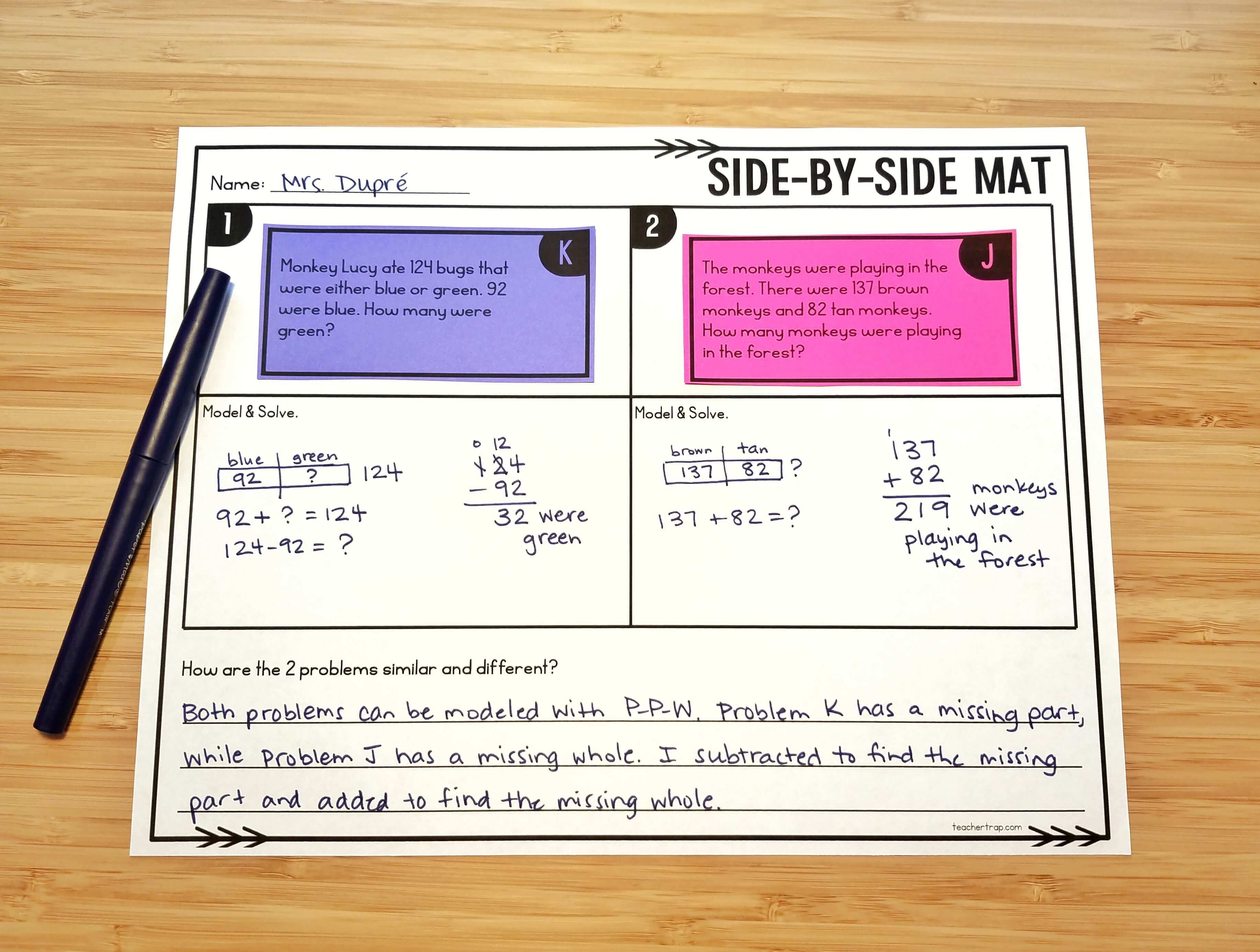
Start With the Easy Version
Differentiation isn’t just for reading! Many students get overwhelmed when they see large numbers in word problems, so why not meet them where they are? I use what I call “Tiered Word Problems” to help students understand word problem structures and grow confidence before tackling the on-level version.
In my Word Problem Solving Bundle, I provide all kinds of leveled word problems – Tiered Problem Pages, Task Cards, Exit Tickets, and more, that all increase in challenge from first through fifth grade. This allows me to scaffold instruction by student need, and throughout the school year.
**You can grab free goodies and sample pages from the Bundle in the Word Problem Solving Bundle Sampler Pack.
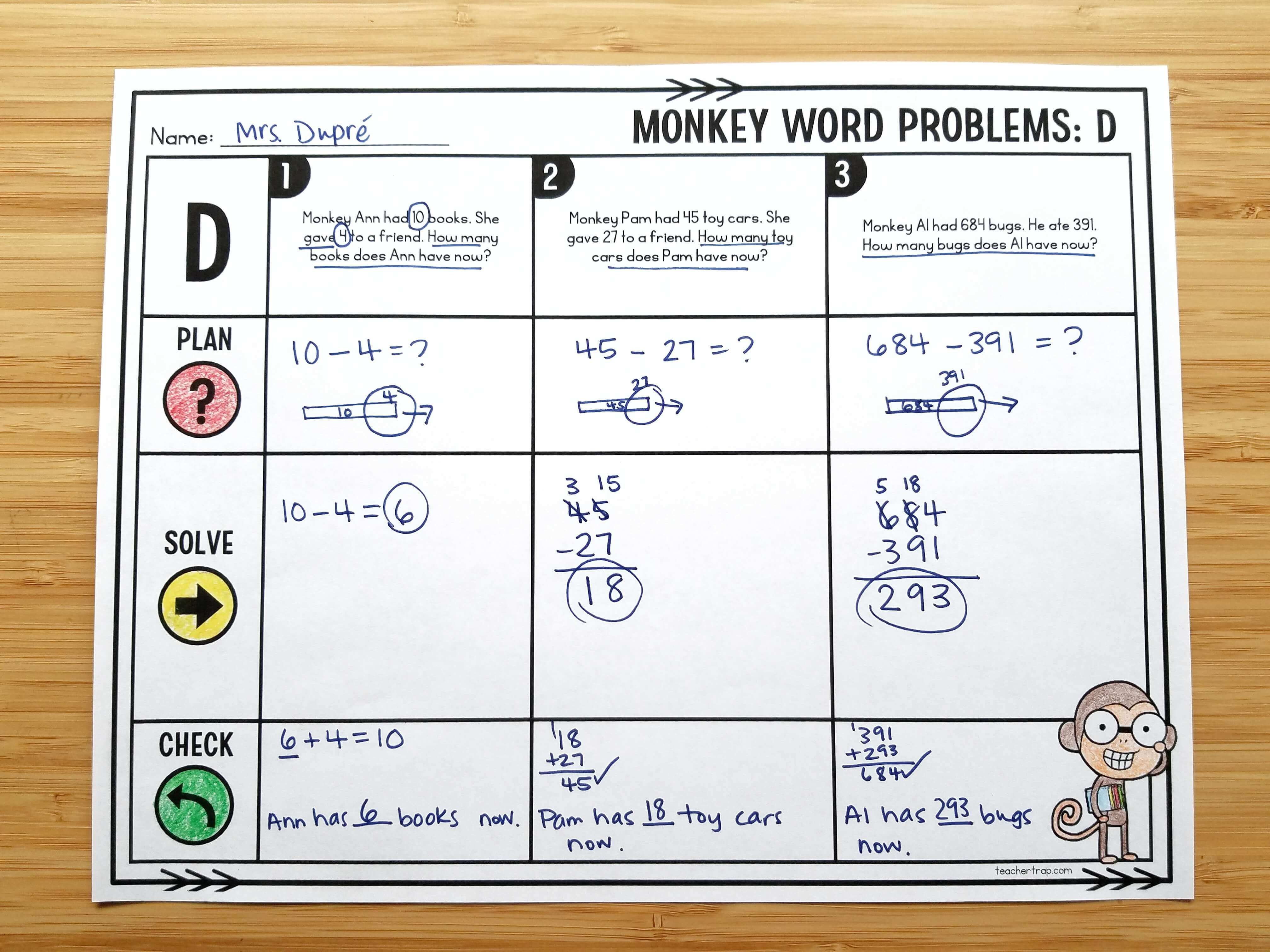
Use Problem-Solving Rounds
Problem-Solving Rounds changed math instruction in my classroom forever! This powerful routine encourages students to move through the problem-solving process I mentioned at the beginning of this post, to explain their thinking, and to reflect on other possible strategies and solutions.
Since using Problem-Solving Rounds, my students are more confident with word problems, have a deeper understanding of problem-types, and are better able to tackle new and challenging tasks.
The basic structure of the rounds follows the Problem-Solving Process I’ve shared. In Round 1, students read and discuss the problem with a focus on UNDERSTANDING. In Round 2, they turn to a partner and explain how they PLAN to solve the problem. They SOLVE the problem independently in Round 3, and in Round 4 they work with a partner and as a whole class to CHECK and reflect on their work. For a detailed guide to this process, check out my blog post all about Problem-Solving Rounds.
I’d love to hear from you! Comment below with your favorite word problem tips for teachers!

This blog post is all about teaching 1st and 2nd grade students a variety of word problem strategies. Starting in 1st grade, students will begin solving word problems in these Common Core math domains: Operations and Algebraic Thinking, Number and Operations in Base Ten, Geometry, and Measurement and Data. By 2nd grade, students are building on their prior knowledge and applying even more word problem strategies for solving problems in these domains. It is important to teach students a variety of strategies in order for them to find the best fit for their learning style.
Different Types of Word Problems
There are many different types of word problems used in mathematics. Students need to be proficient in the different styles of word problems. Additionally, it is key that they know which word problem strategies are appropriate for each style of problem. Today, we will discuss strategies for joining, separating, part-part-whole, missing part, comparison, and multi-step word problems.
Joining word problems- These problems involve 3 numbers, the initial amount, the change amount, and the resulting amount. Students are adding and bringing amounts together.
Separating word problems-These problems are similar to joining, but ask the students to separate or subtract the amounts.
Part-part-whole word problems- Part-part-whole word problems involve only 2 numbers that come together to make up a whole.
Missing part word problems- In this style of problem, students are solving to find the missing part in a part-part-whole problem.
Comparison word problems- Comparison problems involve finding the difference between 2 values. They tend to use words such as “more” and “fewer.”
Multi-step word problems- This problem style involves more than one operation. Students may use a combination of addition and subtraction in 1st and 2nd grade multi-step word problems. Starting in 3rd grade, students will also incorporate multiplication and division.
Create a Mnemonic Device

When teaching word problem strategies to students, it is a great idea to begin with a mnemonic device anchor chart such as this one. This BURST chart will serve as a very important visual aide in your classroom. It will help your students remember the important details and steps in solving word problems. It will also help them eliminate information in the word problem that is not needed to solve the problem.
The BURST strategy stands for:
- Box the important numbers and math information
- Underline the question or action statement
- Restate the question
- Show your work
- Tell your answer and describe your reasoning
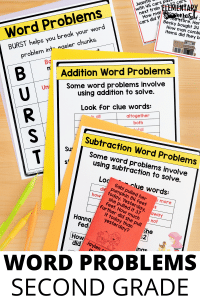
Start with Modeling
Modeling how to use the BURST word problem strategy with a variety of word problem styles is essential. This step-by-step process will help your students think critically through the problems using this strategy. Modeling during whole-group instruction and small groups will help you serve all of your students at their level. By asking guided questions, students will learn how to pick out the important information, the question, and solve for the answer. Modeling how to use the BURST word problem strategy with each style of word problem is key.
Offer Different Ways to Solve
While there are many strategies for solving word problems, it is important to help students find the strategy or strategies that work best for their learning style. Some students will benefit from drawing a picture while others prefer to use an equation. Kinesthetic learners may choose to solve using manipulatives to act out the problem. Allowing students to use the strategy that works best for them is key.
When to Incorporate Word Problems
During a math unit, teachers should incorporate word problems towards the end of the unit. This will ensure that the standard and skill have been taught explicitly first. Students need time to practice the skill before applying it to more complex word problems. As a teacher, use your best judgment to determine when your students are ready for word problems. Some students may be ready before others, which is where small group time is beneficial. This allows for reteaching, extra practice, and enrichment.
Need to Teach Word Problems Virtually?
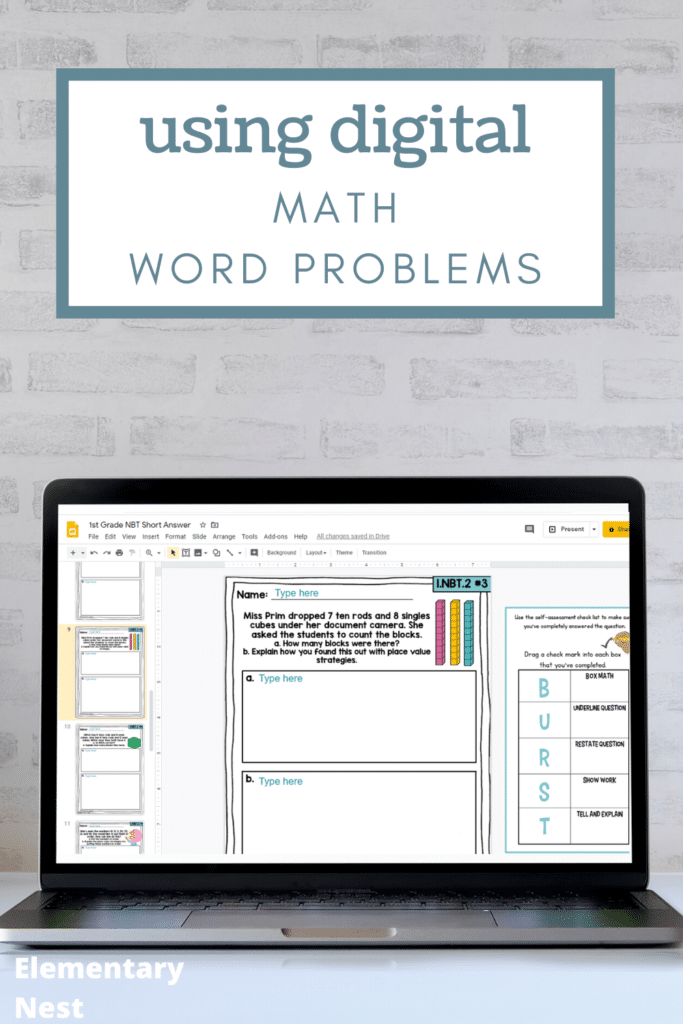
If you are needing an effective, fun way for your students to practice word problems digitally, especially during distance learning, these math word problem resources are for you! These can be completed via Google Slides and shared via Google Classroom.
Need to draw Part A to show your work and solve your problem?
- Click the drop down arrow next to the “line tool” in Google Slides. Scroll down and select the “scribble tool” to draw.
- Students can also solve their math word problems in Google Draw and then upload to Google Classroom or insert that drawing into Part A of their Google Slides problem.
- Another option is for students to solve the problem either on paper or with manipulatives and then snap a picture of their work and insert it into their Slide.
Resources to Help Practice Word Problems
These 1st and 2nd grade word problem resource bundles are available in both paper and digital versions. They come complete with BURST word problem strategy posters and bookmarks, answer keys, rubrics, and a variety of short answer word problems.

- 1st Grade Common Core Aligned Math Word Problems Bundle
- 1NBT- Numbers in Base Ten
- 1OA- Operations and Algebraic Thinking
- 1MD- Measurement and Data
- 1G- Geometry
- 2nd Grade Common Core Aligned Math Word Problems Bundle
- 2NBT- Numbers in Base Ten
- 2OA- Operations and Algebraic Thinking
- 2MD- Measurement and Data
- 2G- Geometry
I also have a 2nd grade unit that comes with ready-made lessons and math group activities. The products above are supplemental word problem activities to practice all the Common Core standards. The unit below is a unit on HOW to teach word problems. It aligns to one specific math standard.
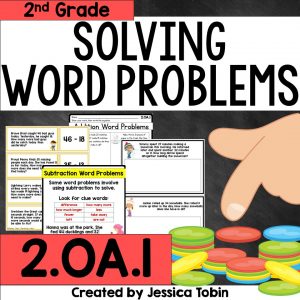
Click the buttons for the link you need.
Thank you so much for reading! I hope you walk away with new ideas on teaching word problems and how to incorporate them into your math lessons.

Looking for other math blog posts to read about?
- Tips for your Measurement Unit
- Strategies for Adding and Subtracting 2-Digit Numbers
- Teaching Kids to Use Number Lines
- Organizing Your Math Block
A word problem is a compilation of several easy-to-understand sentences describing real-life scenarios where a specific problem needs a solution using stepwise mathematical calculation.
Word problems are a crucial part of learning in the curriculum of primary school students because they need children to apply their knowledge about a variety of different concepts to find solutions to a real-life problems.
In classroom settings, children are taught about the acronym RUCSAC which stands for:
i. R- Read
ii. U- Understand
iii. C- Choose
iv. S- Solve
v. A- Answer
vi. C- Check
These values help students to work their minds and apply prior knowledge to yield accurate solutions to problems.
There are four types of operations included in the topic Word Problems. These four operations perform different kinds of functions in different kinds of Word Problems. Students are trained in school to identify the Word Problem and apply the operations required to successfully calculate the result of the Problem.
The Four Operations of Word Problems are explained below in detail.
-
Addition: Addition is the first operation that a Word Problem may contain. Addition, as its name justifies, is about calculating the ‘sum’ of the given numbers. In simple words, it means to add the given numbers together and find a solution.
-
Subtraction: Subtraction is the second operation introduced to students. It is a little more complicated than addition. The subtraction operation is used to calculate ‘take-aways’ from the given numbers. In simple words, it means to subtract one quantity from the larger given quantity and calculate results.
-
Multiplication: Multiplication is the third operation in the list of Word Problems. According to its name, it helps us to calculate the product of two given numbers. In other words, multiplication operates as the process of multiplying the given quantities to yield a result.
-
Division: Lastly, Division is introduced as the fourth operation in the list of operations for Word Problems. Division is a technique through which we can divide the given quantities in a problem. To put it plainly, division operation splits the larger quantity or number into smaller parts.
Word Problems On Four Operations
1. Word Problem Based on Addition: In a class on the day of the examination, the total number of students present in each room was 50. How many students do two examination rooms have?
You need to add the number of students present in both the rooms (50+50) to find the accurate solution to the given problem.
Answer: There are a total of 100 students in 2 examination halls.
2. Word Problem Based on Subtraction: Paul and Amber entered a Card Challenge. They made a huge pyramid from 13687 cards, but Amber accidentally knocked 2956 pieces of cards to the floor before the judges saw their finished work. How many cards were left standing?
The number of cards on the floor (2956) must be subtracted from the total number of cards (13687) to calculate how many cards were still standing.
Answer: There are 10,731(13687-2956) cards standing.
3. Word Problem Based on Multiplication: You are the manager of a furniture company that produces 1350 chairs each month. In a year, how many chairs does the company make?
To calculate this, you need to multiply the number of chairs produced in each month (1350) by the number of months contained in each year (12).
Answer: In a year, a total of 16,200(1350 12) chairs are produced.
4. Word Problem Based on Division: 7000 books need to be arranged equally on a few shelves. If each bookshelf can hold 1000 books, how many bookshelves are required to fit them all?
To answer this problem, you need to divide the number of books one shelf can hold (1000) by the number of total books given (7000).
Answer: 7 bookshelves are required to hold 70000 books.
Mixed Operation Word Problems
Mixed Word Problems consists of the combination of more than one of the Four Operations as mentioned above (addition, subtraction, multiplication, division). They encourage a student to understand and link the various operations needed to solve the problem and build better concentration and think faster.
An Example: If each bottle needs 2 liters of syrup and there are 30 bottles, how much sugar syrup is needed to fill all of them, and how many drinks can be made from one bottle if each glass contains 200 ml syrup? This is a Mixed Word Operation.
Solution: Quantity of syrup each bottle can hold = 2L= 2000mL
Number of bottles = 30
Total quantity of sugar syrup = $30times2$
Ans: i) 60L of syrup can be contained in 30 bottles.
Quantity of syrup in each glass = 200mL
Total number of drinks that can be made with one bottle of syrup = $dfrac{2000}{200}mL$
= 10
Ans: ii) 10 drinks can be made from each bottle.
Solved Examples On Word Problem
An example of a Word Problem is given below:
Example:
Martha bought five apples from the market. She gave one to her mother, one to her brother Jimmy and one to her grandfather. How many apples does she have left?
Solution:
Total number of apples bought by Martha= 5
No. of apples, Martha gave to her mother, her brother, and grandfather= (1+1+1)
Therefore, the no. of remaining apples: 5- (1+1+1)
5- 3 = 2.
Martha has two apples left.
Practice Question MCQs
1. What is the average of: 1,2,3,5,9
-
3
-
4
-
5
-
8
Answer: B)
2. Find the value of: 0.0030.02
-
0.06
-
0.006
-
0.0006
-
0.00006
Answer: D)
Conclusion
The fundamentals of mathematics are arithmetic operations. It contains mostly arithmetic operations like addition, subtraction, multiplication, and division. These are also referred to as mathematical operations. In our daily lives, we employ mathematical operations to calculate overall business income and costs, create a monthly or yearly budget, measure lengths, and so on. We use them virtually every day, for example, while calculating the total number of questions given in homework, time, money, the number of chocolates we ate, the amount of marks gained in all courses, and so on.






